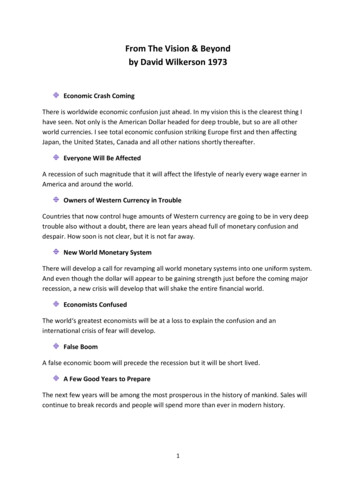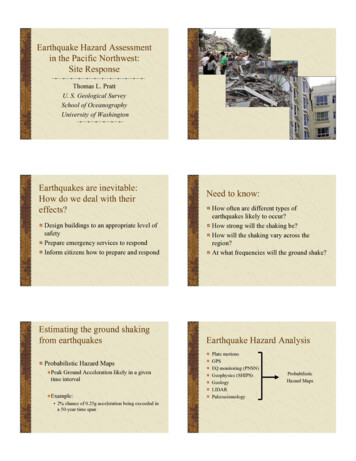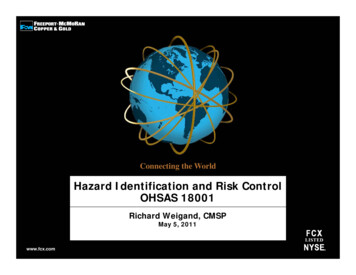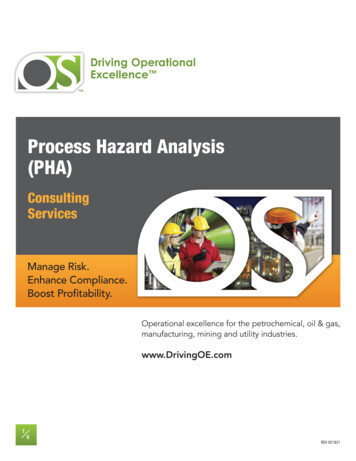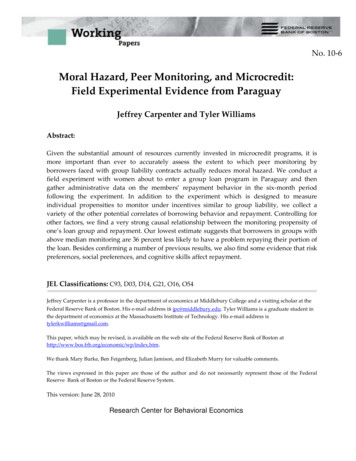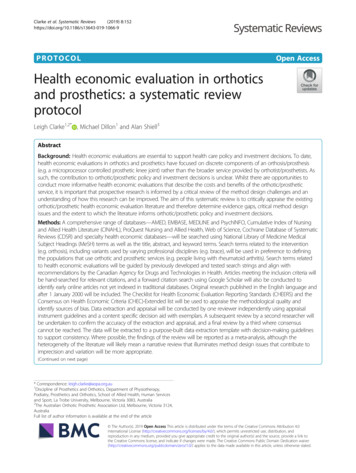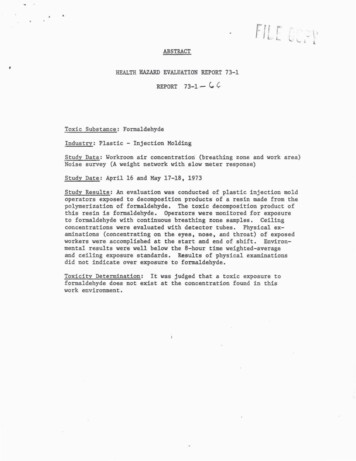
Transcription
FfrL.r rLABSTRACTHEALTH HAZARD EVALUATION REPORT 73-1REPORT73-1- (.Toxic Substance: FormaldehydeIndustry: Plastic - Injection MoldingStudy Data: Workroom air concentration (breathing zone and work area)Noise survey (A weight network with slow meter response)Study Date: April 16 and May 17-18, 1973Study Results: An evaluation was conducted of plastic injection moldoperators exposed to decomposition products of a resin made from thepolymerization of formaldehyde. The toxic decomposition product ofthis resin is formaldehyde. Operators were monitored for exposureto formaldehyde with continuous breathing zone samples. Ceilingconcentrations were evaluated with detector tubes. Physical ex aminations (concentrating on the eyes, nose, and throat) of exposedworkers were accomplished at the start and end of shift. Environ mental results were well below the 8-hour time weighted-averageand ceiling exposure standards. Results of physical examinationsdid not indicate over exposure to formaldehyde.Toxicity Determination: It was judged that a toxic exposure toformaldehyde does not exist at the concentration found in thiswork environment.-i.I.t
HEALTH HAZARD EVALUATION REPORT 73-1HAZARD EVALUATION SERVICES BRANCHDIVISION OF TECHNICAL SERVICESEstablishmentRobin Products Company27027 GroesbeckWarren, MichiganReport Prepared ByRobert E. Rosensteel, Project OfficerPhillip L. Polakoff, M.D., Medical OfficerField EvaluationRobert E. Rosensteel, Industrial Hygiene Engi neerPhillip L. Polakoff, M.D., Medical OfficerPaul E. Caplan, Deputy DirectorDivision of Technical ServicesLaboratory AnalysesA. Wayne Smallwood, ChemistPhysical and Chemical Analysis BranchDivision of Laboratory and Criteria DevelopmentOriginating OfficeJerome P. Flesch, ChiefHazard Evaluation Services BranchCincinnati, OhioSeptember 1973U.S. DEPARTMENT OF HEALTH, EDUCATION, AND WELFARENATIONAL INSTITUTE FOR OCCUPATIONAL SAFETY AND HEALTHCINCINNATI, OHIO45202
TABLE OF CONTENTSI.SUMMARY DETERMINATION . . . . . . . .1II.INTRODUCTION . . . . . . 5BACKGROUND HAZARD EVALUATION.556III.A.B.Federal Standards . . Toxic Effects Iv. · HEALTH HAZARD EVALUATION A.B.C.D.v.Observational Survey Environmental Evaluation.Medical Evaluation.Conclusions . 7781011. . . . .12VI.REFERENCES . . . . . .13VII.TABLES, FIGURES AND PHOTOGRAPHS . . . . . 14RECO NDATIONS
U.S. DEPARTMENT OF HEALTH, EDUCATION, AND WELFARENATIONAL INSTITUTE FOR OCCUPATIONAL SAFETY AND HEALTHCINCINNATI, OHIO45202HEALTH HAZARD EVALUATION REPORT 73-1ROBIN PRODUCTS COMPANYWARREN, MICHIGANSEPTEMBER 19,73I.SUMNARY DETERHINATIONA.IntroductionSection 20(a)(6) of the Occupational Safety and Health Act of 1970,29 U.S.C. 669(a)(6), authorizes the Secretary of Health, Education,and Welfare, following a written request by any employer or authorizedrepresentative of employees to determine whether any substance normallyfound in the place of employment has potentially toxic effects in suchconcentrations as used or found.The National Institute for Occupational Safety and Health (NIOSH)received such a request from an authorized representative of employeesregarding exposure of plastic machine operators and plastic leadersto fumes produced when DuPont Delrin polymer was processed in plasticinjection mold machines at the Robin Products Company, 27027 Groesbeck,Warren, Michigan .B.Federal StandardsThe occupational permissible noise exposures promulgated by theU. S. Department of Labor (Federal Register, October 18, 1972, Title29, Chapter XVII, Subpart G, Section 1910.95) are as follows:Duration per day, hoursSound Level dBA slow responsea864321-1/211/21/4 or less909295971001021051101 5ceiling value
Page 2 - Health Hazard Evaluation Report 73-1The occupational health standard promulgated by the U. S. Departmentof Labor (Federal Register, October 18, 1972, Title 29, Chapter XVII,Subpart G. Section 1910.93, Table G-2) applicable to the substance ofthis evaluation is as follows:Substance8-hour time b Acceptable b Acceptable maximum peak above bweightedceilingthe acceptable ceiling conaverageconcentration concentration for an 8-hour shiftConcentrationFormaldehyde3 ppm5 ppm10 ppmMaximumDuration30 minutesOccupational health standards are established at levels designedto protect workers occupationally exposed to a substance on an 8-hourper day, 40-hour per week basis over a normal working lifetime. en the daily noise exposure is composed of two or more periods ofnoise exposure of different levels, their combined effect should becons i dered, rather than the individual effect of each. If the sumof the following fractions: C1/T 1 C2/T 2 . . . . C /T exceedsunity, then, the mixed exposure should be considered ro gxceed thelimit value. C0 indicates the total time of exposure at a specifiednoise level, and Tn indicates the total time of exposure permittedat that level.bParts of vapor or gas per million parts of contaminated air by volume.C.Environmental Evaluation ResultsNoise measurements were conducted in the injection mold area onMay 17-18, 1973. The full results of this survey may be seen inTable I. Noise levels in excess of those recommended by NIOSH,85 dBA, and the present Feder l Standard, 90 dBA, for an 8-hourexposure were measured at numerous operator stations in this area.Large contributors to the noise levels are the grinders located inthis area. The majority of readings made while grinders processedscrap were greater than 90 dBA slow response.Results of continuous samples for formaldehyde obtained on May17-18, 1973 in the breathing zone of workers ranged from 0.01 to0.10 ppm while static samples in the area ranged from 0.01 to0.53 ppm. Detector tubes were used to measure peak exposures offormaldehyde in operators' breathing zones, and only one measure ment of a total of 28 indicated a measurable level which was 1 ppm.
Page 3 - Health Hazard Evaluation Report 73-1Three detector tubes were used to measure formaldehyde concentrationsat the grinder resulting in levels of 2-4 ppm. Complete formaldehydemeasurements are contained in Tables II, III and IV of the Full Report.D.MedicalEval,uat onResul.t sOn April 16, 1973, an initial walk-through survey was undertaken.At that time no Delrio or Celcon was being utilized in the manufacturingprocess. Occupational and medical histories were obtained from nineworkers. All the workers questioned stated that when Delrin and toa lesser extent, Celcon, were processed into molded plastic parts,they suffered from burning of the eyes, dryness of the nose, irri tation of the throat and tightness in the chest. None of the workershave ever missed work due to the alleged hazard.On May 17-18, 1973, the process was re-inspected. At this timetwo extruder molding machines were in operation using Delrio andCelcon. Ten other machines were processing Zytel (nylon). Thisrepresented a typical production day. Seldom are there more thantwo machines in operation using Delrin or Celcon. Occupational andmedical histories plus physical examinations (concentrating on theeyes, nose and throat) were performed on the 12 women machine opera tors prior to and after their eight hour work shift.In inspecting the extruder molding machines using Delrio andCelcon, the medical investigator could, subjectively, detect tracesof the characteristically harsh, pungent odor of formaldehyde.While interviewing and examining the workers, the followinginformation was obtained: The employee operating the machine whichwas processing Delrin stated that both before and after the workshift she experienced no adverse symptomatology. Clinical examina tion at these times revealed no abnormalities of the eyes, nose,and throat. The employee operating the machine which was processingCelcon stated that she felt well in the morning, but after the workshift she complained of hoarsenss and nasal dryness. It was notedthat her eyes, nose and pharynx were within normal limits in themorning. In the afternoon, on follow-up examination, her con junctiva were slightly injected, the nasal mucous membranes extremelydry and the pharynx within nolj1Ilal limits.The women using Zytel on the day of our investigation all gavea rather similar story. They all felt well prior to the work shiftbut at the end of the shift complained of dryness of the nose,varying degrees of burning of the eyes, and hoarseness in thethroat. Six of ten employees examined at the end of the shift haddry nasal mucous membranes. Three others had slightly injectedconjunctiva and one or two had mildly erythematous pharynx,
Page 4 - Health Hazard Evaluation Report 73-1E. Toxicity DeterminationIt is concluded by the investigators that toxic exposure toformaldehyde does not exist at the concentrations found in thiswork environment. However, conditions can occur which mightcause unnecessary worker discomfort and lead to insidious adversehealth affects. More specifically, prolonged dryness of the nasalmucous membranes may retard or prevent the normal filtering mechanismof airborne pollutants. This determination is based upon (1) medicalhistories (2) physical examination of workers and (3) environmentalmeasurements of formaldehyde concentrations. In addition a largenumber of workers in this production facility are exposed to ex cessive noise for protracted periods of time based upon noise mea surements made in the injection mold area.F.DistributionCopies of this Summary Determination are available from theHazard Evaluation Services Branch, NIOSH, U.S. Post Office Building,Room 508, 5th and Walnut Streets, Cincinnati, Ohio 45202. Copieshave been sent to:a)b)c)d)RobinPlantU. S.NIOSHProducts CompanyChairman, Local No. 189, UAWDepartment of Labor - Region V- Region VFor purposes of informing the approximately 65 affected employeesof the results of this investigation, the employer shall post a copyof this Summary Determination for a period of 30 calendar days at ornear the work places of affected employees.
Page 5 - Health Hazard Evaluation Report 73-1II.INTRODUCTIONSection 20(a)(6) of the Occupational Safety and Health Act of 1970,29 U.S.C. 669(a)(6), authorizes the Secretary of Health, Education, andWelfare, following a written request by any employer or authorizedrepresentative of employees to determine whether any substance normallyfound in the place of employment has potentially toxic effects in suchconcentrations as used or found.The National Institute for Occupational Safety and Health (NIOSH)received such a request from an authorized representative of employeesregarding exposure of plastic machine operators and plastic leadersto fumes produced when DuPont Delrin polymer was processed in plasticinjection mold machines at the Robin Products Company, 27027 Groesbeck,Warren, Michigan .The Robin Products Company is engaged in the manufacture of metaland plastic parts with most of the production consumed by theautomobile industry. In the plastic production area of the plant aplastic resin is received as pellets in bags or drums, the appropriateresin is injected into a mold with the waste being ground up for reuse,the molded parts are audited, and the finished parts are packagedfor shipment to the customer. Several polymer raw materials are useddepending upon the characteristics desired in the end product. Thereare approximately 65 employees who potentially could be exposed tofumes produced during processing in the molding area of the plant.Technical information obtained from DuPont warns against heating theDelrin polymer above 450 F since decomposition to formaldehyde canoccur under this condition. The polymer should not be heated above347 F for prolonged periods.III.BACKGROUND HAZARD INFORMATIONA.Federal StandardsThe occupational permissible noise exposures promulgated by theU. S. Department of Labor (Federal Register, October 18, 1972, Title29, Chapter XVII, Subpart G, Section 1910.95) are as follows:
Page 6 - Health Hazard Evaluation Report 73-1Sound level dBA slow responseaDuration per day, hours8643290929597100102105110115 ceiling value1 1 or lessThe occupational health standard promulgated by the U.,s. Departmentof Labor (Federal Register, October 18, 1972, Title 29, Chapter XVII,Subpart G, Section 1910.93, Table G-2) applicable to the substance ofthis evaluation is:Substance8-hour nAcceptable maximum peak abovebthe acceptable ceiling concen tration for an 8-hour shiftConcentrationFormaldehyde3ppm5 ppm10 ppmMaximumDuration30 minutesOccupational health standards are established at levels designedto protect workers occupationally exposed to a substance on a 8-hourper day, 40-hour per week basis over a normal working lifetime.B.Toxic EffectsNoiseExposures to intense noises may lead to a loss in hearing which maybe temporary or permanent. Loss of hearing will be noted by a measuredshift in the hearing threshold. When recovery to normal hearing thresholdsoccurs, the shift is known as ','temporary 11 When fuil recovery does nota When the daily noise exposure is composed of two or more periods ofnoise exposure of different levels, their combined effect should beconsidered, rather than the individual effect of each. If the sumof the following fractions: c1 tT1 CziT2 . Cn/Tn exceeds unity,then, the mixed exposure should be considered to exceed the limit value .indicates the total time of exposure at a specified noise level,and indicates the total time of exposure permitted at that level.enb Parts of vapor or gas per million parts of contaminated air by volume.
Page 7 - Health Hazard Evaluation Report 73-1occur, the shift is known as "permanent". Not all persons aresusceptible to hearing loss at the same noise level. Therefore,it is not possible to set up a simple relation between hearingloss and noise level. However, standards have been establishedto protect the majority of the people.FormaldehydeFormaldehyde is a colorless gas with an irritating odor thatis perceptible at less than one ppm.The principal hazard in industrial use is from the va ors offormaldehyde. Irritation of the membranes of the eyes and upperrespiratory passages results from excessive exposure. Rep atedexposures may result in inflammation of the eyelids. Chronicirritation to the eyes, nose and upper respiratory tract may resultfrom repeated exposures to the vapors. Inhalation of high concen trations can cause laryngitis, bronchitis, and broncho-pneumonia.Repeated contact with the skin has a hardening or tanning effectand causes irritation. Prolonged or repeated contact may producecracking of the skin and ulceration, particularly around the finger nails. Skin sensitization or dermatitis has been a common occurrencefrom prolonged and repeated contact with formaldehyde solutions orwith products containing free formaldehyde.A threshold limit value of 5 ppm by volume in air has been setby some agencies as the safe conce tration for an eight hour exposure,but few workers will be comfortable at such concentrations. TheAmerican Conference of Governmental Industrial Hygienists (ACGIH)has set the TLV at a 2 ppm ceiling.IV.HEALTH HAZARD EVALUATIONA.Observational SurveyOn April 16, 1973 NIOSH representatives Messrs. Paul Caplan,Robert Rosensteel and Dr. Phillip Polakoff arrived at the RobinProducts Company, Warren, Michigan to conduct an initial visit inresponse to a request for a hea th hazard evaluation. A meetingwas held with company officials in which the ."Official Notice",1970 Occupational Safety and Health Act, and Hazard Evaluationregulations were presented. An explanation of Section 20(a)(6) ofthe Act was given as well as the necessity for subsequent visitsand the reportmechanisms of a hazard evaluation.
Page 8 - Health Hazard Evaluation Report 73-1A walk-through inspection was conducted by the NIOSH investigatorsaccompanied by plant and union officials. The storage, extrusion,auditing, packaging and shipping areas of the plant were observed.The walk-through was concentrated in the extrusion area of the plant.The DuPont Delrio polymer which had caused initiation of the requestwas not being processed during the inspection. The Delrio polymeris processed for 2-3 days out of every two weeks. Waste plasticproduced during extrusion is reground so it may be reused. Thegrinders caused noise levels in the extrusion area which requiredshouting in order to be heard when attempting to speak in this area.During the walk-through a Celanese product called Celcon was beingprocessed on No. 9 and No. 15 machines. This polymer is similar toDelrio. Six detector tubes were used to measure formaldehyde levelsin the areas near these machines, but no color change was noted onany tubes. The lowest measurable limit of the tubes used was twoppm, but a color change can be seen at a lower level.On two occasions minor nose and eye irritation was noted near oneof the grinders by the investigators and the characteristic formalde hyde odor was easily distinguishable at several locations. The presentproduction rate of Delrio and Celcon is about 8000 pounds per month.Upon completion of the walk-through the National Surveillance Networkquestionnaire was completed.On April 6, 1973, an initial walk-through survey was undertakenby NIOSH medical officer, Dr. Phillip L. Polakoff. Occupationalmedical histories were obtained from nine workers. All the workersquestioned stated that when Delrio and to a lesser extent, Celcon,are being processed they noted burning of the eyes, dryness of thenose, irritation of the throat and tightness in the chest. Noneof the workers have ever missed work due to the alleged hazard.B. Environmental EvaluationThe environmental evaluation was directed at determining theexposure of workers to formaldehyde vapors in the injection moldarea of the plant. In addition, noise levels in this area weresuspected of being excessive o the basis of observations made bythe NIOSH investigators during the conduct of the initial visit.
Page 9 - Health Hazard Evaluation Report - 73-1It has been determined that "substances" as presently defined inSection 20(a)(6) of the Act do not include physical agents. However,for completeness of our overall responsibilities for acknowledgingany occupational hazards we encounter during the course of our evaluationin the worksite in question, noise levels are reported in thisevaluation.A noise survey of the injection mold area of the plant was made onMay 16 and 18, 1973. Sound pressure levels were made with a GeneralRadio Company Type 1565-B Sound Level Meter on the A-weighting networkat slow response. The results of these measurements are contained inTable I. Large contributors to excessive noise levels in the injectionmold area are the grinders located at various positions in the area,generally one grinder per two injection mold machines.Measurements were made while grinders were operating under variousconditions. The approximate location of grinders in relation to theinjection mold machines at the time of the survey may be seen byreferring to Figure 1.The high noise levels measured when scrap was not actually beingground show other sources of excessive noise also exist in this area.Of special note is the pnuematic press used at Machine No. 8 forseparating finished parts which exposes the operator to high noiselevels for a significant part of the work period. The presentintention expressed by management to replace the existing grinders withsound deadened grinders should help lower overall noise leve s in thisarea. If equipment is modified or new equipment is purchasep carefulconsideration should be given to engineering controls to reduce noiselevels for such equipment. NIOSH has recommended a lowering of thenoise standard for new installations to a level of 85 dBA slow responsewhich would also apply to established installations following afeasibility study by the Secretary of Labor fn consultation
two extruder molding machines were in operation using Delrio and Celcon. Ten other machines were processing Zytel (nylon). This represented a typical production day. Seldom are there more than two machines in operation using Delrin or Celcon. Occupational and medical h

